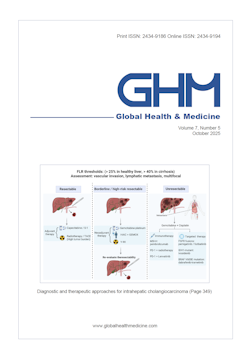Global Health & Medicine 2024;6(6):404-415.
Higher FIB-4 index at baseline predicts development of liver cancer in a community-based cohort with viral hepatitis
Kimura M, Nishikawa T, Shimakami T, Terashima T, Horii R, Fukuda M, Yoshita M, Takata N, Hayashi T, Funaki M, Nio K, Takatori H, Arai K, Yamashita T, Honda M, Tanaka J, Kaneko S, Yamashita T
Hepatitis B and C (HBV and HCV) testing has been performed in Japan since 2002 and is subsidized by central and prefectural governments. A follow-up program for HBV- or HCV-infected persons was started at that time in Ishikawa Prefecture. This study analyzed the long-term follow-up data from this program. In total, 1029 participants in the Ishikawa Hepatitis Follow-up Program (HBV-infected, n = 535; HCV-infected, n = 494) were enrolled. Clinical data between the first visit and the most recent visit by March 2019 were collected. In the HBV-infected group, 384 persons (71.8%) were asymptomatic carriers, 133 (24.9%) developed chronic hepatitis, 15 (2.8%) developed compensated liver cirrhosis, and 3 (0.6%) developed decompensated liver cirrhosis. Ninety (16.8%) were treated with nucleotide/nucleoside analogs. Sixteen (3.0%) developed liver cancer. In the HCV-infected group, 427 persons (86.4%) developed chronic hepatitis, 46 (9.3%) developed compensated liver cirrhosis, and 21 (4.3%) developed decompensated liver cirrhosis. Forty-eight (9.7%) developed liver cancer. Three hundred and seventy-eight (76.5%) received antiviral therapy (a direct-acting antiviral in 166, interferon-based treatment followed by a direct-acting antiviral in 73, and interferon-based treatment in 139). The subsidy system was used by 270 persons (71.4%). Sustained virological response was confirmed in 340 persons (68.8%). A higher FIB-4 index at the first visit was a significant risk factor for liver cancer in HBV-infected and HCV-infected persons. The Ishikawa Hepatitis Follow-up Program has revealed the clinical course of HBV and HCV infection in community-dwelling individuals. The results will be used for micro-elimination at a prefectural level.
DOI: 10.35772/ghm.2024.01008







